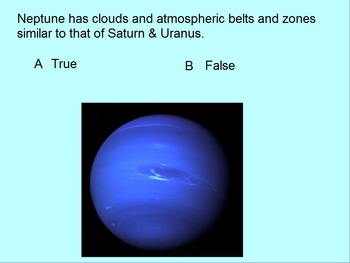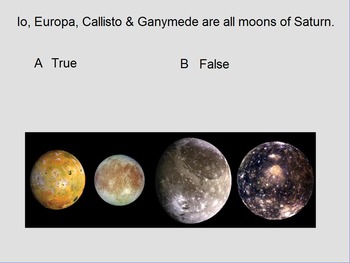Earth/Space ActivInspire Unit Assessment Review "The Solar System"
- Flipchart File
Description
This review aligns with the Common Core State Standards (CCSS):
"STANDARD 8 - The Universe and Practices of Science.
8A. understands the properties and dynamic nature of the solar system.
8D. observes, describes, and explains the relative and apparent motions of objects in the sky.
8G. demonstrates the ability to use instruments or to explain functions of the technologies and tools used in the study of the space sciences."
ActivInspire unit review on "The Solar System" (Unit XIII). The review contains 20 interactive questions including true/false and multiple choice. Graphics and images are added to each slide to help with student understanding. A PDF student study guide/worksheet can also be generated using this program.
*All PowerPoint lessons; ActivInspire programs; student note sheets/activities and assessments for this unit can be found under the "Earth/Space Complete Unit XIII Planet The Solar System" zip file folder.
Terms/concepts in this unit include:
solar system, geocentric, heliocentric, planets, Mars, Sun, Moon ,retrograde motion, epicycles, deferent, orbits, Ptolemy, Aristarchus, Copernicus, solar nebula, condensation theory, planetesimals, Jovian planets, extrasolar planet, exoplanet, Kepler telescope, Kepler-62 system, light year, Inner planets, Mercury, Venus, Earth , Mars, cratering, planetary atmospheres, magnetic fields, planetary composition, runaway greenhouse effect, carbon dioxide, global warming, astronomical unit, plate tectonics, mountain ranges, red planet, Valles Marineris, Olympus Mons, weathering, planetary tilt, seasons, Phobos, Deimos, Mariner, Viking , Pioneer, gas giants, Jupiter, Saturn, Uranus, Neptune, Voyager, Galileo, Great Red Spot, Io, Europa, Ganymede, Callisto, natural satellites, moons, oceans, Saturn's rings, Titan, methane lakes, Huygens probe, Cassini, Uranus' rings, Uranus' tilt, Great Dark Spot, Triton, cryo volcanoes, Pluto, dwarf planets, major planets, comets, Comet McNaught, Halley's Comet, Oort cloud, nucleus, coma, tail, meteor showers, Geminids, meteor, meteoroid, meteorite, asteroid, Barringer crater, Ceres, NEAR spacecraft, Apophis
astronomydad
This work is licensed under a Creative Commons Attribution 3.0 Unported License.





